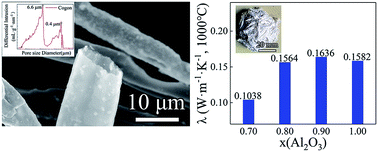Preparation and heat-insulating properties of Al2O3–ZrO2(Y2O3) hollow fibers derived from cogon using an orthogonal experimental design†
Abstract
Bionic design is efficient to develop high-performance lightweight refractories with sophisticated structures such as hollow ceramic fibers. Here, we report a four-stage procedure for the preparation of Al2O3–ZrO2(Y2O3) hollow fibers using the template of cogon—a natural grass. Subsequently, to optimize the thermal performance of the fibers, four sets of preparation parameters, namely, x(Al2O3), solute mass ratio of the mixture, dry temperature, and sintering temperature were investigated. Through an orthogonal design, the optimal condition of each parameter was obtained as follows: x(Al2O3) was 0.70, solute mass ratio of the mixture was 15 wt%, dry temperature was 80 °C, and sintering temperature was 1100 °C. Overall, Al2O3–ZrO2(Y2O3) hollow fibers show relatively low thermal conductivity (0.1038 W m−1 K−1 at 1000 °C), high porosity (95.0%), and low density (0.05–0.10 g cm−3). The multiphase compositions and morphology of Al2O3–ZrO2(Y2O3) hollow fibers, which may contribute to their thermal properties, were also discussed.



 Please wait while we load your content...
Please wait while we load your content...